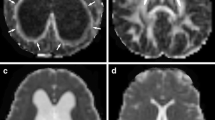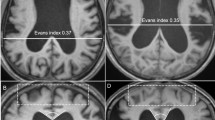Abstract
To investigate morphological changes in the corpus callosum in hydrocephalus and to correlate them with clinical findings we studied sagittal T2*-weighted cine MR images of 163 patients with hydrocephalus. The height, length and cross-sectional area of the corpus callosum were measured and related to the type of cerebrospinal fluid flow anomaly and to clinical features, especially dementia. With expansion of the lateral ventricles the corpus callosum showed mainly elevation of its body and, to a lesser degree, increase in length. Upward bowing was more pronounced in noncommunicating than in communicating hydrocephalus. Dorsal impingement on the corpus callosum by the free edge of the falx correlated with the height of the corpus callosum. Cross-sectional area did not correlate with either height, length or impingement; it was, however, the strongest anatomical discriminator between demented and nondemented patients. The area of the corpus callosum was significantly smaller in patients with white matter disease. Our findings suggest that, due to its plasticity, the corpus callosum can to some degree resist distortion in hydrocephalus. Dementia, although statistically related to atrophy of the corpus callosum, is possibly more directly related to white matter disease.
Similar content being viewed by others
References
Georgy BA, Hesselink JR, Jernigan TL (1993) MR imaging of the corpus callosum. AJR 160: 949–955
Moody DM, Bell MA, Challa VR (1988) The corpus callosum, a unique white-matter tract: anatomic features that may explain sparing in Binswanger disease and resistance to flow of fluid masses. AJNR 9: 1051–1059
Naidich TP, Daniels DL, Haughton VM, Williams A, Pojunas K, Palacios E (1987) Hippocampal formation and related structures of the limbic lobe: anatomic-MR correlation. I. Surface features and coronal sections. Radiology 162: 747–754
Naidich TP, Daniels DL, Haughton VM, Pech P, Williams A, Pojunas K, Palacios E (1987) Hippocampal formation and related structures of the limbic lobe: anatomic-MR correlation. II. Sagittal sections. Radiology 162: 755–761
Nolte J (1988) The human brain. An introduction to its functional anatomy. Mosby, St. Louis, pp 50, 358–359
Peterson HO, Kieffer SA (1972) Introduction to neuroradiology. Harper & Row, Hagerstown, pp 121, 157–163
El Gammal TE, Allen MB, Brooks BS, Mark EK (1987) MR evaluation of hydrocephalus. AJNR 8: 591–597
Jinkins JR (1991) Clinical manifestation of hydrocephalus caused by impingement of the corpus callosum on the falx: an MR study in 40 patients. AJNR 12: 331–340
Jinkins JR (1991) The MR equivalents of cerebral hemispheric disconnection: a telencephalic commissuropathy. Comput Med Imaging Graph 15: 323–331
McLeod NA, Williams JP, Machen B, Lum GB (1987) Normal and abnormal morphology of the corpus callosum. Neurology 37: 1240–1242
Bradley WG (1992) Magnetic resonance imaging in the evaluation of cerebrospinal fluid flow abnormalities. Magn Reson Q 8: 169–196
Bradley WG, Whittemore AR, Kortman KE, Watanabe AS, Homyak M, Teresi LM, Davis SJ (1991) Cerebrospinal fluid void: indicator of successful shunt in patients with suspected normal-pressure hydrocephalus. Radiology 178: 459–466
Kunz U, Heintz P, Ehrenheim C, Stolke D, Dietz H, Hundeshagen H (1989) MRI as the primary diagnostic instrument in normal pressure hydrocephalus. Psychiatry Res 29: 287–288
Zimmerman RD, Fleming CA, Lee BCP, Saint-Louis LA, Deck MDF (1986) Periventricular hyperintensity as seen by magnetic resonance: prevalence and significance. AJNR 7: 13–20
Lang J, Ederer M (1980) Über Form und Größe des Corpus callosum und das Septum pellucidum. Gegenbaurs Morphol Jahrb 126: 949–958
Laissy JP, Patrux B, Duchateau C, Hannequin D, Hugonet P, Ait-Yahia H, Thiebot J (1993) Midsagittal MR measurements of the corpus callosum in healthy subjects and diseased patients: a prospective survey. AJNR 14: 145–154
Dieteman JL, Beigelman C, Rumbach L, Vogue M, Tajahmady T, Faubert C, Jeung MY, Wackenheim A (1988) Multiple sclerosis and corpus callosum atrophy: relationship of MRI findings to clinical data. Neuroradiology 30: 478–480
Huber SJ, Bornstein RA, Rammohan KW, Christy JA, Chakeres DW, McGee RB (1992) Magnetic resonance imaging correlates of neuropsychological impairment in multiple sclerosis. J Neuropsychiatr 4: 152–158
Huber SJ, Paulson GW, Shuttleworth EC, Chakeres D, Clapp LE, Pakalnis A, Weiss K, Rammohan K (1987) Magnetic resonance imaging correlates of dementia in multiple sclerosis. Arch Neurol 44: 732–736
Pelletier J, Habib M, Lyon-Caen O, Salomon G, Poncet M, Khalil R (1993) Functional and magnetic resonance imaging correlates of callosal involvement in multiple sclerosis. Arch Neurol 50: 1077–1082
Weihe W, Loew M, Schulze-Siedschlag J, Horstmann A, Welter FL, Mariß G (1989) Multiple Sklerose: Balkenatrophie und Psychosyndrom. Nervenarzt 60: 414–419
Schlote W (1991) HIV-Enzephalopathie. Verh Dtsch Ges Pathol 75: 51–60
Tanaka Y, Tanaka O, Mizuno Y, Mitsuo Y (1989) A radiologic study of dynamic process in lacunar dementia. Stroke 20: 1488–1493
Yamanouchi H, Sugiura S, Shimada H (1990) Loss of nerve fibres in the corpus callosum of progressive subcortical vascular encephalopathy. J Neurol 237: 39–41
Ikeda M, Tsukagoshi H (1990) Encephalopathy due to toluene sniffing. Report of a case with magnetic resonance imaging. Eur Neurol 30: 347–349
Iwabuchi K, Yagishita S, Amano M, Yokoi S, Honda H, Tanabe T, Kinoshita J, Kosaka K (1990) An autopsy case of complicated form of spastic paraplegia with amyotrophy, mental deficiency, sensory impairment, and parkinsonism. No To Shinkei 42: 1075–1083
George AE (1991) Chronic communicating hydrocephalus and periventricular white matter disease: a debate with regard to cause and effect. AJNR 12: 42–44
Jack CR, Mokri B, Laws ER, Houser OW, Baker HL, Petersen RC (1987) MR findings in normal-pressure hydrocephalus: significance and comparison with other forms of dementia. J Comput Assist Tomogr 11: 923–931
Benes V (1982) Sequelae of transcallosal surgery. Child's Brain 9: 69–72
Viallet F, Massion J, Massarino R, Khalil R (1992) Coordination between posture and movement in a bimanual lifting task: putative role of a medial frontal region including the supplementary motor area. Exp Brain Res 88: 674–684
Baron R, Heuser K, Marioth G (1989) Marchiafava-Bignami disease with recovery diagnosed by CT and MRI: demyelination affects several CNS structures. J Neurol 236: 364–366
Bracard S, Claude D, Vespignani H, Almeras M, Carsin M, Lambert H, Picard L (1986) Scanographie et IRM de la maladie de Marchiafava-Bignami. J Neuroradiol 13: 87–94
Chang KH, Cha SH, Han MH, Park SH, Nah DL, Hong JH (1992) Marchiafava-Bignami disease: serial changes in corpus callosum on MRI. Neuroradiology 34: 480–482
Yoshii F, Shinohara Y, Duara R (1990) Cerebral white matter bundle alterations in patients with dementia of Alzheimer type and patients with multi-infarct dementia-magnetic resonance imaging study. Rino Shink 30: 110–112
Yamanouchi H, Sugiura S, Shimada H (1989) Decrease of nerve fibres in the anterior corpus callosum of senile dementia of Alzheimer type (letter). J Neurol 236: 491–492
Delangre T, Hannequin D, Clavier E, Denis P, Mihout B, Samson M (1986) Maladie de marchiafava-Bignami d'evolution favorable. Rev Neurol 142: 933–936
Namba Y, Bando M, Takeda K, Iwata M, Mannen T (1991) Marchiafava-Bignami disease with symptoms of the motor impersistence and unilateral hemispatial neglect. Rinso Shink 31: 632–635
Rosa A, Demiati M, Cartz L, Mizon JP (1991) Marchiafava-Bignami disease, syndrome of interhemispheric disconnection and right-handed agraphia in a left-hander. Arch Neurol 48: 986–988
Canaple S, Rosa A, Mizon JP (1992) Maladie de Marchiafava-Bignami: disconnexion interhémispherique, evolution favorable. Aspect neuroradiologique. Rev Neurol 148: 638–640
Fletcher JM, Bohan TP, Brandt ME, Brookshire BL, Beaver SR, Francis DJ, Davidson KC, Thompson NM, Miner ME (1992) Cerebral white matter and cognition in hydrocephalic children. Arch Neurol 49: 818–824
Gadsdon DR, Variend S, Emery JL (1978) The effect of hydrocephalus upon the myelination of the corpus callosum. Z Kinderchir 25: 311–318
Castro-Caldas A, Poppe P, Antunes JL, Campos J (1989) Partial section of the corpus callosum: focal signs and their recovery. Neurosurgery 25: 442–447
Rudge P, Warrington EK (1991) Selective impariment of memory and visual perception in splenial tumours. Brain 114: 349–360
Rubin RC, Hochwaldt GM, Tiell M, Mizutani H, Ghatak N (1976) Hydrocephalus. I. Histological and ultrastructural changes in the pre-shunted cortical mantle. Surg Neurol 5: 109–114
Kameyama M (1973) Vascular lesions in the frontal association field and dementia. Clin Psychiatr 15: 357–366
Roessmann U, Friede RL (1968) Surface lesions of corpus callosum. Acta Neuropathol 10: 151–158
Sidtis JJ, Volpe BT, Holtzman JD, Wilson DH, Gazzaniga MS (1981) Cognitive interaction after staged callosal section. Evidence for transfer of semantic activation. Science 212: 344–346
Warrington EK, Weiskrantz L (1982) Amnesia: a disconnection syndrome? Neuropsychologia 20: 233–248
Clark RC, Milhorat TH (1976) Experimental hydrocephalus, part 3. Light microscopic findings in acute and subacute obstructive hydrocephalus in the monkey. J Neurosurg 32: 400–413
Author information
Authors and Affiliations
Additional information
Dedicated to Prof. M. Nadjmi on the occasion of his sixty-fifth birthday
Rights and permissions
About this article
Cite this article
Hofmann, E., Becker, T., Jackel, M. et al. The corpus callosum in communicating and noncommunicating hydrocephalus. Neuroradiology 37, 212–218 (1995). https://doi.org/10.1007/BF01578260
Received:
Accepted:
Issue Date:
DOI: https://doi.org/10.1007/BF01578260




